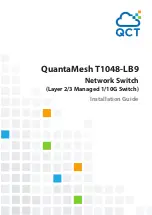
Glossary
125
Internet Protocol.
The method or protocol by which data
is sent from one computer to another on the Internet. Each
computer (known as a host) on the Internet has at least one
IP address that uniquely identifies it among all other
computers on the Internet. When you send or receive data
(for example, an e-mail note or a Web page), the message
gets divided into little chunks called packets. Each of these
packets contains both the sender's Internet address and the
receiver's address. Any packet is sent first to a gateway
computer that understands a small part of the Internet. The
gateway computer reads the destination address and
forwards the packet to an adjacent gateway that in turn
reads the destination address and so forth across the
Internet until one gateway recognizes the packet as
belonging to a computer within its immediate
neighborhood or domain. That gateway then forwards the
packet directly to the computer whose address is specified.
Because a message is divided into a number of packets,
each packet can, if necessary, be sent by a different route
across the Internet. Packets can arrive in a different order
than they were sent. The Internet Protocol just delivers
them. It's up to another protocol, the Transmission Control
Protocol (TCP) to put them back in the right order. IP is a
connectionless protocol, which means that there is no
continuing connection between the end points that are
communicating. Each packet that travels through the
Internet is treated as an independent unit of data without
any relation to any other unit of data. (The reason the
packets do get put in the right order is because of TCP, the
connection-oriented protocol that keeps track of the packet
sequence in a message.) In the Open Systems
Interconnection (OSI) communication model, IP is in
Layer 3, the Networking Layer. The most widely used
version of IP today is IP version 4 (IPv4). However, IP
version 6 (IPv6) is also beginning to be supported. IPv6
provides for much longer addresses and therefore for the
possibility of many more Internet users. IPv6 includes the
capabilities of IPv4 and any server that can support IPv6
packets can also support IPv4 packets.
IVL.
Independent VLAN Learning (IVL) allows unicast
address-to-port mappings to be created based on a MAC
Address in conjunction with a VLAN ID.
L
LAN.
See “Local Area Network” on page 125.
Learning.
The bridge examines the Layer 2 source
addresses of every frame on the attached networks (called
listening) and then maintains a table, or cache, of which
MAC addresses are attached to each of its ports.
Local Area Network.
A group of computers that are
located in one area and are connected by less than 1,000
feet of cable. A typical LAN might interconnect
computers and peripherals on a single floor or in a single
building. LANs can be connected together, but if modems
and telephones connect two or more LANs, the larger
network constitutes what is called a WAN or Wide Area
Network.
M
MAC.
(1) Medium Access Control. In LANs, the
sublayer of the data link control layer that supports
medium-dependent functions and uses the services of the
physical layer to provide services to the logical link
control (LLC) sublayer. The MAC sublayer includes the
method of determining when a device has access to the
transmission medium. (2) Message Authentication Code.
In computer security, a value that is a part of a message or
accompanies a message and is used to determine that the
contents, origin, author, or other attributes of all or part of
the message are as they appear to be. (
IBM Glossary of
Computing Terms
)
Management Information Base.
When SNMP devices
send SNMP messages to the management console (the
device managing SNMP messages), it stores information
in the MIB.
MDC.
Management Data Clock.
MDI.
Management Data Interface.
MDIO.
Management Data Input/Output.
MDIX.
Management Dependent Interface Crossover.
MIB.
See “Management Information Base” on page 125.
Multicasting.
To transmit a message to specific
recipients across a network. A simple example of
multicasting is sending an e-mail message to a mailing list.
Teleconferencing and videoconferencing also use
multicasting, but require more robust protocols and
networks. Standards are being developed to support
multicasting over a TCP/IP network such as the Internet.
These standards, IP Multicast and Mbone, will allow users
to easily join multicast groups. Note that multicasting
refers to sending a message to a select group whereas
broadcasting refers to sending a message to everyone
connected to a network. The terms multicast and
narrowcast are often used interchangeably, although
narrowcast usually refers to the business model whereas
multicast refers to the actual technology used to transmit
the data.
Содержание DES-3226L
Страница 2: ......
Страница 11: ...List of Figures 11 List of Figures Figure 1 Mode based CLI 26 Figure 2 Syntax Error Message 28...
Страница 12: ...12 D Link DES 3226L Command Line Reference...
Страница 14: ...14 D Link DES 3226L Command Line Reference...
Страница 16: ...16 D Link DES 3226L Command Line Reference...
Страница 18: ...18 D Link DES 3226L Command Line Reference...
Страница 24: ...24 D Link DES 3226L Command Line Reference...
Страница 50: ...50 D Link DES 3226L Command Line Reference...
Страница 82: ...82 D Link DES 3226L Command Line Reference...
Страница 104: ...104 D Link DES 3226L Command Line Reference...
Страница 122: ...122 D Link DES 3226L Command Line Reference...




































